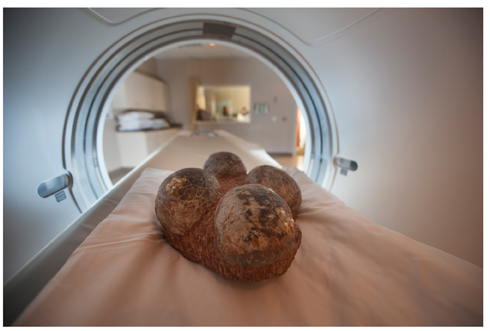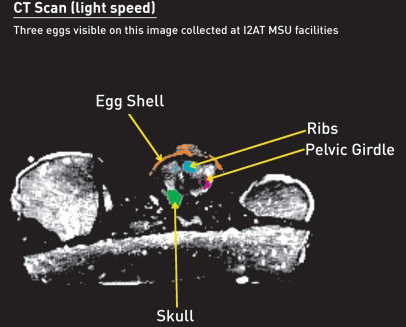Cracking the Secrets of Dinosaur Eggs
University Team Hope to use Synchrotron Light Source to Scan Dinosaur Eggs
Scientists from Mississippi State University hope to learn more about the contents of dinosaur eggs using the Diamond Light Synchrotron facility based near Didcot in Oxfordshire to “virtually dissect” fossil material. In an international collaboration with researchers from the National Museum of Wales, the intention is to produce three-dimensional, X-ray images of two batches of Late Cretaceous dinosaur eggs from Montana. The first set of fossilised dinosaur eggs, each one about the size of a Galia melon, was found in 2002, the second clutch of eggs was found last year at the same location.
Dinosaur Eggs
It is the first time, (as far as we at Everything Dinosaur are aware), that scientists will examine dinosaur eggs using a synchrotron in a bid to identify the dinosaur species from an embryo. Leading the research, is Geosciences doctoral student at Mississippi State, John Paul Jones, he was lucky to have found the dinosaur eggs whilst exploring part of the Judith River Formation.
One of the batches of eggs has already been subjected to CT (computerised tomography) scanning, this has helped reveal evidence of dinosaur bones in some of the eggs, however, the images and data produced by the Diamond Light Source should help John Paul Jones identify the species and perhaps even the gender of the embryos.
Both the CT scans and the synchrotron method are non-destructive, the actual fossil material remains undamaged and intact.
The Geosciences student explained:
“If you cut it, then you have a damaged egg. It’s just a rock that has been sliced in half. With the synchrotron technology, we will get the actual image that can be used to make a model. We should get a three-dimensional replica of the bones.”
Identifying the Dinosaur Species
If the images are able to provide greater clarity of the skull material along with the pelvic bones, it is hoped that the species of dinosaur that laid the eggs will be revealed. The scientists are fairly confident that the eggs were produced by a hadrosaur, trouble is, a number of hadrosaur fossil remains are associated with the strata that make up this part of the Judith River Group. Could the eggs be from a Brachylophosaurus or a lambeosaurine duck-billed dinosaur?
Indeed, the eggs could provide evidence of other types of hadrosaur living in this part of Montana at this time in the Late Cretaceous (between 80 and 75 million years ago), or perhaps the eggs could be from an entirely new to science species of dinosaur.
Some of the Dinosaur Fossil Eggs Having a CT Scan
Picture credit: Megan Bean
The Devil’s Coulee Fossil Site
Recently, Everything Dinosaur reported on a media day that took place in southern Alberta at the famous Devil’s Coulee fossil site. A team from the Royal Tyrrell Museum took members of the public and the media on a tour of this highly fossiliferous location looking at the remains of dinosaur nests and eggs that had been found there.
To read more about this article: Updates on Alberta’s Scrambled Eggs.
The Devil’s Coulee site is part of the Oldman Formation of Alberta. This strata is between 77 and 75 million years old. These rocks are contemporaneous with parts of the Judith River Group, so it is possible that these locations may share closely related hadrosaurine fauna.
At this stage, the scientists are reluctant to speculate on any species identification. From the lower resolution scans a potential skull crest has been identified on one embryo. The synchrotron should be able to create a series of three-dimensional slices through the fossil material.
These slices can be used by a computer programme to build a 3-D model of the contents. If the resolution is high enough, a species identification could be made. If this is the case, then we at Everything Dinosaur think that this might be a first for palaeontology.
The Diamond Light Source
The doughnut shaped Diamond Light Source (Didcot, Oxfordshire) is in essence, a particle accelerator, with a circumference in excess of half a kilometre. Electrons are generated and fired out into the synchrotron, these electrons are then accelerated to very near light speed. They give off energy in the form of intense light. This light can be channelled via “beamlines” and it is this very bright light source that enables scientists to X-ray solid objects such as rocks containing fossils to produce 3-D pictures of the contents.
As these extremely strong X-rays travel through an object, the different densities of the fossil material and the surrounding matrix absorb different parts of the X-ray light spectrum. These different absorption rates are then used to plot data and produce the images.
One of the Images Generated by the Recent CT Scans
Picture credit: Megan Bean; submitted image highlighted by Hayley Gilmore
The picture above shows an image from a CT scan, the egg shell and fossilised bones have been labelled and highlighted. In the other eggs, the resolution of the scanner was not high enough to create a definite internal image.
Researchers involved in this joint project between the American university and National Museum of Wales, hope to use an analysis of zircon crystals deposited amongst ash from ancient volcanic eruptions within the Judith River Formation to more accurately date the eggs. A better idea of the age of the dinosaur eggs will help the team to assess which dinosaur species potentially produced these clutches.



